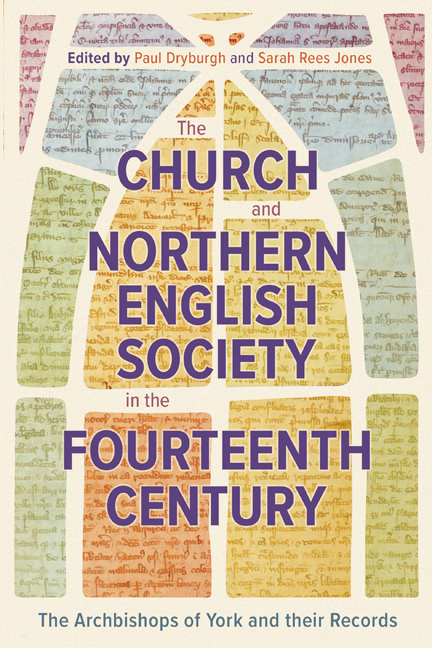 The Church and Northern English Society in the Fourteenth Century
The Church and Northern English Society in the Fourteenth Century Book contents
- Frontmatter
- Dedication
- Contents
- List of Illustrations
- List of Contributors
- Acknowledgements
- List of Abbreviations
- Map: The Ecclesiastical Province of York, c. 1304–1405
- Introduction
- 1 The Administrative Records of the Archbishops of York, 1304–1405
- 2 The Archbishops of York and the Government of Fourteenth-Century England
- 3 Support or Scourge? Archbishop William Melton and the Tradition of Loyal Opposition to the English
- 4 Beyond the Border: The Influence of York Clerks in the Two Edwards’ Scottish Administrations, 1332–1357
- 5 Responding to Royal Requirements: Clerical Taxation in the Province of York, 1304–1405
- 6 Ad insolenciam ipsius rebellis salubrius reprimendam: William Thorntoft, the Abbey of Rufford and Significations of Excommunication in the Northern Province
- 7 Blood, Sex and Holy Water: Reconciling Churches and Churchyards in the Medieval Diocese of York
- 8 Structuring Episcopal Authority: Palaces and Residences of the Archbishop of York
- 9 Medieval Parks of the Archbishops of York
- 10 Northern Ways? Pilgrimage, Politics and Piety in the Fourteenth-Century Administrative Records of the Archdiocese of York
- 11 Underexplored Sources for Gender History: New Approaches to the Fourteenth-Century York Archbishops’ Registers
- 12 Joan of Leeds and other Apostate Nuns in the Province of York, 1300–1350
- Bibliography of Records of the Archbishops of York, 1304–1405
- Index
9 - Medieval Parks of the Archbishops of York
Published online by Cambridge University Press: 17 May 2024
- Frontmatter
- Dedication
- Contents
- List of Illustrations
- List of Contributors
- Acknowledgements
- List of Abbreviations
- Map: The Ecclesiastical Province of York, c. 1304–1405
- Introduction
- 1 The Administrative Records of the Archbishops of York, 1304–1405
- 2 The Archbishops of York and the Government of Fourteenth-Century England
- 3 Support or Scourge? Archbishop William Melton and the Tradition of Loyal Opposition to the English
- 4 Beyond the Border: The Influence of York Clerks in the Two Edwards’ Scottish Administrations, 1332–1357
- 5 Responding to Royal Requirements: Clerical Taxation in the Province of York, 1304–1405
- 6 Ad insolenciam ipsius rebellis salubrius reprimendam: William Thorntoft, the Abbey of Rufford and Significations of Excommunication in the Northern Province
- 7 Blood, Sex and Holy Water: Reconciling Churches and Churchyards in the Medieval Diocese of York
- 8 Structuring Episcopal Authority: Palaces and Residences of the Archbishop of York
- 9 Medieval Parks of the Archbishops of York
- 10 Northern Ways? Pilgrimage, Politics and Piety in the Fourteenth-Century Administrative Records of the Archdiocese of York
- 11 Underexplored Sources for Gender History: New Approaches to the Fourteenth-Century York Archbishops’ Registers
- 12 Joan of Leeds and other Apostate Nuns in the Province of York, 1300–1350
- Bibliography of Records of the Archbishops of York, 1304–1405
- Index
Summary
When the intrepid antiquarian John Leland travelled across Yorkshire around 1540, on leaving the archbishop's ‘very fair castel’ at Cawood, he described the route to Sherburn in Elmet as ‘wel woodid, and almost stil riding by a riveret caullid Bishop's water’, and passing ‘by a parke (as I thinke) of the bishops of Yorke’. The maps of Christopher Saxton of 1577 (Figure 9.1) and John Speed of 1611 show three enclosed parks in the area that Leland described, represented by circular fenced enclosures, at ‘Rust park’ (Rest), where the archbishops had created another residence, at Scalm park, and at Thorpe (which had belonged to Selby Abbey), among a wooded area named ‘The owt wood’. A man-made watercourse running from Sherburn to Cawood is also clearly shown on the two maps, which Leland called ‘Bishop's water’ and is known today as Bishop Dyke. The site of the archbishops’ former parks, now Bishop Wood, although largely replanted, still forms the largest area of woodland in the Vale of York, and this study examines what the digitised and indexed archbishops’ registers can reveal about this and the other medieval parks of the archbishops of York.
Administrative registers might seem unlikely and unpromising sources in which to discover details about the parks of the archbishop, but they offer important new insights into these recreational and economic assets, which are otherwise little documented. The registers of the archbishops offer the opportunity to understand more about the distribution, use and management of the medieval parks and associated woodland during the high and late Middle Ages. Entries in the registers include references to hunting, gifts from parks and forests, income generated, the appointment of foresters and parkers and the punishment of poachers, which can be examined alongside historic maps and landscape evidence to identify these parks and understand their operation.
Historians, archaeologists and ecologists often take varying perspectives to interpreting medieval parks, depending in part on the types of evidence used. They have debated whether medieval parks functioned primarily for hunting and amenity purposes, as enclosed areas for keeping deer, or whether they were predominantly of value for grazing, timber and woodland produce. The most recent comprehensive study sees the persistent importance of the aristocratic hunting culture as the defining feature of medieval parks and argues that they were maintained predominantly for leisure rather than as economic assets.
- Type
- Chapter
- Information
- The Church and Northern English Society in the Fourteenth CenturyThe Archbishops of York and their Records, pp. 225 - 246Publisher: Boydell & BrewerPrint publication year: 2024


